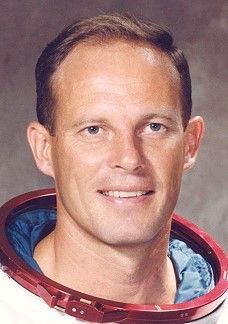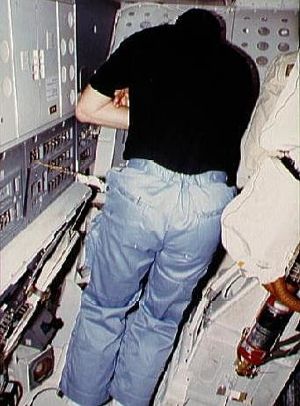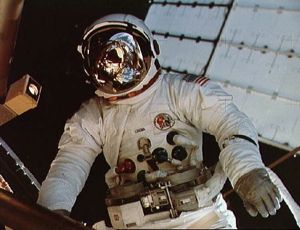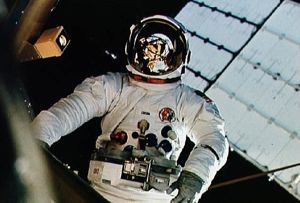
Home - Search - Browse - Alphabetic Index: 0- 1- 2- 3- 4- 5- 6- 7- 8- 9
A- B- C- D- E- F- G- H- I- J- K- L- M- N- O- P- Q- R- S- T- U- V- W- X- Y- Z
Lousma, Jack Robert
 Lousma Credit: www.spacefacts.de |
Status: Inactive; Active 1966-1983. Born: 1936-02-29. Spaceflights: 2 . Total time in space: 67.47 days. Birth Place: Grand Rapids, Michigan.
Educated Michigan; USNPGS.
Official NASA Biography as of June 2016:Jack Robert Lousma (Colonel, USMC, Ret.)
NASA Astronaut (former)
PERSONAL DATA: Born February 29, 1936, in Grand Rapids, Michigan. Lousma and his wife, Gratia Kay, have been married since 1956. They have four children and six grandchildren. He is a golfing enthusiast and enjoys hunting, fishing, and aviation.
EDUCATION: Graduated from Ann Arbor High School in Ann Arbor, Michigan; received a bachelor of science degree in Aeronautical Engineering from the University of Michigan in 1959, and a master of science degree in Aeronautical Engineering from the U. S. Naval Postgraduate School in 1965; presented an honorary doctorate of Astronautical Science from the University of Michigan in 1973, an honorary Doctor of Science from Hope College in 1982, and an honorary Doctor of Science in Business Administration from Cleary College in 1986.
ORGANIZATIONS: Fellow of the American Astronautical Society; member of the Society of the Sigma Xi, the University of Michigan "M" Club, the Officer's Christian Fellowship, and the Association of Space Explorers.
SPECIAL HONORS: Awarded the Johnson Space Center Certificate of Commendation (1970) and the NASA Distinguished Service Medal (1973); presented the Navy Distinguished Service Medal and the Navy Astronaut Wings (1974), the City of Chicago Gold Medal (1974), the Robert J. Collier Trophy for 1973 (1974), the Marine Corps Aviation Association's Exceptional Achievement Award (1974), the Federation Aeronautique Internationale's V. M. Komarov Diploma for 1973 (1974), the Dr. Robert H. Goddard Memorial Trophy for 1975 (1975), the AIAA Octave Chanute Award for 1975 (1975), the AAS Flight Achievement Award for 1974 (1975); inducted into the International Space Hall of Fame (1982). NASA Distinguished Service Medal (1982), Department of Defense Distinguished Service Medal (1982), NCAA Silver Anniversary Award (1983). Inducted into the Michigan Aviation Hall of Fame (1988).
EXPERIENCE: Lousma was a reconnaissance pilot with VMCJ-2, 2nd Marine Air Wing, at Cherry Point, North Carolina, before being assigned to Houston and the Lyndon B. Johnson Space Center. He became a Marine Corps officer in 1959 and received his wings in 1960 after completing training at the U.S. Naval Air Training Command. He was then assigned to VMA-224, 2nd Marine Air Wing, as an attack pilot and later served with VMA-224, 1st Marine Air Wing, at Iwakuni, Japan. He has logged 7000 hours of flight time--including 700 hours in general aviation aircraft and 1619 hours in space, 4,500 hours in jet aircraft, 240 hours in helicopters, and 700 hours in general aviation aircraft.
NASA EXPERIENCE: Lousma is one of the 19 astronauts selected by NASA in April 1966. He served as a member of the astronaut support crews for the Apollo 9, 10, and 13 missions. He was the pilot for Skylab-3 (July 28 to September 25, 1973) and was spacecraft commander on STS-3 (March 22-30, 1982), logging a total of over 1,619 hours in space. Lousma also spent 11 hours on two spacewalks outside the Skylab space station. He also served as backup docking module pilot of the United States flight crew for the Apollo-Soyuz Test Project (ASTP) mission which was completed successfully in July 1975.
Jack Lousma left NASA in 1983.
SPACE FLIGHT EXPERIENCE: Skylab-3 (SL-3) (July 28 to September 25, 1973). The crew on this 59-1/2 day flight included Alan L. Bean (spacecraft commander), Jack Lousma (pilot), and Owen K. Garriott (science-pilot). SL-3 accomplished 150% of mission goals while completing 858 revolutions of the earth and traveling some 24,400,000 miles in earth orbit. The crew installed six replacement rate gyros used for attitude control of the spacecraft and a twin-pole sun-shade used for thermal control, and they repaired nine major experiment or operational equipment items. They devoted 305 man hours to extensive solar observations from above the earth's atmosphere, which included viewing two major solar flares and numerous smaller flares and coronal transients. Also acquired and returned to earth were 16,000 photographs and 18 miles of magnetic tape documenting earth resources observations. The crew completed 333 medical experiment performances and obtained valuable data on the effects of extended weightlessness on humans. Skylab-3 ended with a Pacific Ocean splashdown and recovery by the USS NEW ORLEANS.
STS-3, the third orbital test flight of space shuttle Columbia, launched from the Kennedy Space Center, Florida, on March 22, 1982, into a 180-mile circular orbit above the earth. Jack Lousma was the spacecraft commander and C. Gordon Fullerton was the pilot on this 8-day mission. Major flight test objectives included exposing the Columbia to extremes in thermal stress and the first use of the 50-foot remote manipulator system (RMS) to grapple and maneuver a payload in space. The crew also operated several scientific experiments in the orbiter's cabin and on the OSS-1 pallet in the payload bay. Space Shuttle Columbia responded favorably to the thermal tests and was found to be better than expected as a scientific platform. The crew accomplished almost 100% of the objectives assigned to STS-3, and after a 1-day delay due to bad weather, landed on the lakebed at White Sands, New Mexico, on March 30,1982, having traveled 3.4 million miles during 129.9 orbits of the earth. Mission duration was 192 hours, 4 minutes, 49 seconds.
FEBRUARY 1999
This is the only version available from NASA. Updates must be sought from the above named individual.
Official Biography
NAME: Jack R. Lousma
BIRTHDATE AND PLACE: Lousma was born February 29, 1936, in Grand Rapids, Michigan.
EDUCATION: Lousma received a Bachelor of Science degree in aeronautical engineering from the University of Michigan in 1959 and a degree of aeronautical engineer from the U.S. Naval Postgraduate School in 1965.
EXPERIENCE: Lousma became a Marine Corps officer in 1959 and received his flight wings a year later at the U.S. Naval Air Training Command. He served with the 2nd Marine Air Wing as an attack pilot and with the 1st Marine Wing based in Japan. He was a reconnaissance pilot with the 2nd Marine Air Wing, flying out of Cherry Point, North Carolina, when NASA selected him as one of 19 new astronauts in April 1966.
Lousma served as Command Module Pilot for the second manned Skylab mission, Skylab 3, launched on July 28, 1973. The other crew members were Commander Alan Bean and Science Pilot Owen K. Garriott. They would spend 59 days aboard the space workshop. Lousma conducted two space walks during the mission. On the tenth day of the mission, he and Garriott conducted an EVA, replacing film in the external solar telescope and erecting a second sun shade over the area of the station where a protective heat shield had ripped away during launch. On the second EVA, with Garriott, the telescope film was again changed out. During the course of the mission Earth resources photography, solar astronomy, metals processing and biological experiments were conducted.
Lousma returned to space March 22, 1982, as Commander of the third flight of the Space Shuttle. During eight days in orbit, he and Pilot Gordon Fullerton exposed the shuttle to extremes in thermal stress, tested the craft's 16 m long robot arm, and conducted science experiments. Because of bad weather at the prime landing site at Edwards Air Force Base, California, Lousma flew the shuttle to its only landing at a high altitude backup landing site at White Sands, New Mexico, on March 30.
Thereafter Lousma retired from NASA and the Marine Corps, and became an official of The Diamond General Corporation.
More at: Lousma.
Family: Astronaut. Country: USA. Spacecraft: Skylab. Flights: Apollo 13, Skylab 3, Apollo 20, Apollo (ASTP), STS-2A, STS-3. Projects: Apollo, ASTP, STS. Agency: USMC. Bibliography: 5713.
 | STS-3 Commander Lousma sleeps on aft flight deck Credit: NASA |
 | Skylab 3 Astronaut Jack Lousma participates in EVA to deploy twin pole solar shield Credit: NASA |
 | Skylab 3 Astronaut Jack Lousma participates in EVA to deploy twin pole solar shield Credit: NASA |
 | STS-3 Commander Lousma is surrounded by a week's worth of trash on the middeck Credit: NASA |
1936 February 29 - .
- Birth of Jack Robert Lousma - . Nation: USA. Related Persons: Lousma. American pilot astronaut 1966-1983. 2 spaceflights, 67.5 days in space. Flew to orbit on Skylab 3 (1973), STS-3..
1966 April 4 - .
- NASA Astronaut Training Group 5 selected. - .
Nation: USA.
Related Persons: Brand,
Bull, John,
Carr,
Duke,
Engle,
Evans,
Givens,
Haise,
Irwin,
Lind,
Lousma,
Mattingly,
McCandless,
Mitchell,
Pogue,
Roosa,
Swigert,
Weitz,
Worden.
The group was selected to provide pilot-astronauts for the Apollo Applications Program (then planned as 10 lunar landings after Apollo 11 and 30 Apollo flights to earth-orbit space stations).. Qualifications: Qualified jet pilot with minimum 1,000 flight-hours, bachleor's degree in engineering or physical or biological sciences, under 35 years old, under 183 cm height, excellent health. US citizen.. 351 applications (including six women and a legless US Navy pilot). All 19, except X-15 astronaut Engle, would fly into space on Apollo or Skylab missions. Engle and six others would fly shuttle missions.
1970 April 11 - . 19:13 GMT - . Launch Site: Cape Canaveral. Launch Complex: Cape Canaveral LC39A. Launch Platform: LUT3. Launch Vehicle: Saturn V.
- Apollo 13 - .
Call Sign: Odyssey. Crew: Haise,
Lovell,
Swigert.
Backup Crew: Duke,
Mattingly,
Young.
Support Crew: Brand,
Kerwin,
Lousma.
Payload: Apollo CSM 109 / Apollo LM 7 / ALSEP / S-IVB-508. Mass: 28,790 kg (63,470 lb). Nation: USA.
Agency: NASA Houston.
Program: Apollo.
Class: Moon.
Type: Manned lunar spacecraft. Flight: Apollo 13.
Spacecraft: Apollo CSM.
Duration: 5.95 days. Decay Date: 1970-04-17 . USAF Sat Cat: 4371 . COSPAR: 1970-029A. Apogee: 186 km (115 mi). Perigee: 184 km (114 mi). Inclination: 32.50 deg. Period: 88.31 min.
Apollo 13 (AS-508) was launched from Pad A, Launch Complex 39, KSC, at 2:13 p.m. EST April 11, with astronauts James A. Lovell, Jr., John L. Swigert, Jr., and Fred W. Haise, Jr., aboard. The spacecraft and S-IVB stage entered a parking orbit with a 185.5-kilometer apogee and a 181.5-kilometer perigee. At 3:48 p.m., onboard TV was begun for five and one-half minutes. At 4:54 p.m., an S-IVB burn placed the spacecraft on a translunar trajectory, after which the CSM separated from the S-IVB and LM Aquarius. (The crew had named lunar module 7 Aquarius and CSM 109 Odyssey.) The CSM then hard-docked with the LM. The S-IVB auxiliary propulsion system made an evasive maneuver after CSM/LM ejection from the S-IVB at 6:14 p.m. The docking and ejection maneuvers were televised during a 72-minute period in which interior and exterior views of the spacecraft were also shown.
At 8:13 p.m. EST a 217-second S-IVB auxiliary propulsion system burn aimed the S-IVB for a lunar target point so accurately that another burn was not required. The S-IVB/IU impacted the lunar surface at 8:10 p.m. EST on April 14 at a speed of 259 meters per second. Impact was 137.1 kilometers from the Apollo 12 seismometer. The seismic signal generated by the impact lasted 3 hours 20 minutes and was so strong that a ground command was necessary to reduce seismometer gain and keep the recording on the scale. The suprathermal ion detector experiment, also deployed by the Apollo 12 crew, recorded a jump in the number of ions from zero at the time of impact up to 2,500 shortly thereafter and then back to a zero count. Scientists theorized that ionization had been produced by 6,300 K to 10,300 K (6,000 degrees C to 10,000 degrees C) temperature generated by the impact or that particles had reached an altitude of 60 kilometers from the lunar surface and had been ionized by sunlight.
Meanwhile back in the CSM/LM, the crew had been performing the routine housekeeping duties associated with the period of the translunar coast. At 30:40 ground elapsed time a midcourse correction maneuver took the spacecraft off a free-return trajectory in order to control the arrival time at the moon. Ensuring proper lighting conditions at the landing site. The maneuver placed the spacecraft on the desired trajectory, on which the closest approach to the moon would be 114.9 kilometers.
At 10:08 p.m. EST April 13, the crew reported an undervoltage alarm on the CSM main bus B, rapid loss of pressure in SM oxygen tank No. 2, and dropping current in fuel cells 1 and 3 to a zero reading. The loss of oxygen and primary power in the service module required an immediate abort of the mission. The astronauts powered up the LM, powered down the CSM, and used the LM systems for power and life support. The first maneuver following the abort decision was made with the descent propulsion system to place the spacecraft back in a free-return trajectory around the moon. After the spacecraft swung around the moon, another maneuver reduced the coast time back to earth and moved the landing point from the Indian Ocean to the South Pacific.
1973 July 28 - . 11:10 GMT - . Launch Site: Cape Canaveral. Launch Complex: Cape Canaveral LC39B. Launch Platform: LUT1. LV Family: Saturn I. Launch Vehicle: Saturn IB.
- Skylab 3 - .
Call Sign: Skylab. Crew: Bean,
Garriott,
Lousma.
Backup Crew: Brand,
Lenoir,
Lind.
Payload: Apollo CSM 117. Mass: 20,121 kg (44,359 lb). Nation: USA.
Agency: NASA Houston.
Program: Skylab.
Class: Moon.
Type: Manned lunar spacecraft. Flight: Skylab 3.
Spacecraft: Apollo CSM.
Duration: 59.46 days. Decay Date: 1973-09-25 . USAF Sat Cat: 6757 . COSPAR: 1973-050A. Apogee: 442 km (274 mi). Perigee: 422 km (262 mi). Inclination: 50.00 deg. Period: 93.20 min.
Continued maintenance of the Skylab space station and extensive scientific and medical experiments. Installed twinpole solar shield on EVA; performed major inflight maintenance; doubled record for length of time in space. Completed 858 Earth orbits and 1,081 hours of solar and Earth experiments; three EVAs totalled 13 hours, 43 minutes.
The space vehicle, consisting of a modified Apollo command and service module payload on a Saturn IB launch vehicle, was inserted into a 231.3 by 154.7 km orbit. Rendezvous maneuvers were performed during the first five orbits as planned. During the rendezvous, the CSM reaction control system forward firing engine oxidizer valve leaked. The quad was isolated. Station-keeping with the Saturn Workshop began approximately 8 hours after liftoff, with docking being performed about 30 minutes later.
1973 August 7 - . 17:30 GMT - .
- EVA Skylab 3-1 - .
Crew: Garriott,
Lousma.
EVA Duration: 0.27 days. Nation: USA.
Related Persons: Garriott,
Lousma.
Program: Skylab.
Class: Manned.
Type: Manned space station. Flight: Skylab 3.
Spacecraft: Skylab.
Installed second sunshade. Replaced solar camera film cartridges. During EVA by crew members of Skylab 3, a twin-boom sunshade, developed by MSFC, was deployed over the parasol of the OWS. A redesigned and refined thermal parasol had been launched with Skylab 3. However, its use would have required jettisoning the parasol deployed by crew members of Skylab 2, with the possibility of creating the same thermal problems that existed on the OWS prior to the parasol deployment. Following erection of the twin-pole sunshade, the cabin temperature stayed at a comfortable 293-297 K (67.7°F-74.9°F).
1973 August 24 - . 16:24 GMT - .
- EVA Skylab 3-2 - . Crew: Garriott, Lousma. EVA Duration: 0.19 days. Nation: USA. Related Persons: Garriott, Lousma. Program: Skylab. Class: Manned. Type: Manned space station. Flight: Skylab 3. Spacecraft: Skylab. Replaced solar camera film cartridges; installed replacement gyroscopes..
1973 September 25 - . 22:19 GMT - .
- Landing of Skylab 3 - . Return Crew: Bean, Garriott, Lousma. Nation: USA. Related Persons: Bean, Garriott, Lousma. Program: Skylab. Flight: Skylab 3. Skylab 3 landed at 22:19 GMT..
1974 July - .
- Apollo 20 (cancelled) - .
Crew: Lind,
Lousma,
Roosa.
Nation: USA.
Related Persons: Lind,
Lousma,
Roosa.
Program: Apollo.
Flight: Apollo 20.
Spacecraft: Apollo CSM.
The preferred landing site was the Marius Hills, or, if the operational constraints were relaxed, the bright crater Tycho. The flight was cancelled on January 4, 1970, before any crew assignments were made. The most likely crew would have been Roosa (Commander); Lind (Lunar Module Pilot); and Lousma (Command Module Pilot).
1975 July 15 - . 19:50 GMT - . Launch Site: Cape Canaveral. Launch Complex: Cape Canaveral LC39B. Launch Platform: LUT1. LV Family: Saturn I. Launch Vehicle: Saturn IB.
- Apollo (ASTP) - .
Call Sign: Apollo. Crew: Brand,
Slayton,
Stafford.
Backup Crew: Bean,
Evans,
Lousma.
Payload: Apollo CSM 111. Mass: 14,768 kg (32,557 lb). Nation: USA.
Agency: NASA Houston.
Program: ASTP.
Class: Moon.
Type: Manned lunar spacecraft. Flight: Apollo (ASTP),
Soyuz 19 (ASTP).
Spacecraft: Apollo CSM.
Duration: 9.06 days. Decay Date: 1975-07-24 . USAF Sat Cat: 8032 . COSPAR: 1975-066A. Apogee: 166 km (103 mi). Perigee: 152 km (94 mi). Inclination: 51.70 deg. Period: 87.60 min.
This flight marked the culmination of the Apollo-Soyuz Test Project, a post-moon race 'goodwill' flight to test a common docking system for space rescue. 15 July 1975 began with the flawless launch of Soyuz 19. Apollo followed right on schedule. Despite a stowaway - a 'super Florida mosquito' - the crew accomplished a series of rendezvous manoeuvres over the next day resulting in rendezvous with Soyuz 19. At 11:10 on 17 July the two spacecraft docked. The crew members rotated between the two spacecraft and conducted various mainly ceremonial activities. Stafford spent 7 hours, 10 minutes aboard Soyuz, Brand 6:30, and Slayton 1:35. Leonov was on the American side for 5 hours, 43 minutes, while Kubasov spent 4:57 in the command and docking modules.
After being docked for nearly 44 hours, Apollo and Soyuz parted for the first time and were station-keeping at a range of 50 meters. The Apollo crew placed its craft between Soyuz and the sun so that the diameter of the service module formed a disk which blocked out the sun. This artificial solar eclipse, as viewed from Soyuz, permitted photography of the solar corona. After this experiment Apollo moved towards Soyuz for the second docking.
Three hours later Apollo and Soyuz undocked for the second and final time. The spacecraft moved to a 40 m station-keeping distance so that the ultraviolet absorption (UVA MA-059) experiment could be performed. This was an effort to more precisely determine the quantities of atomic oxygen and atomic nitrogen existing at such altitudes. Apollo, flying out of plane around Soyuz, projected monochromatic laser-like beams of light to retro-reflectors mounted on Soyuz. On the 150-meter phase of the experiment, light from a Soyuz port led to a misalignment of the spectrometer, but on the 500-meter pass excellent data were received; on the 1,000-meter pass satisfactory results were also obtained.
With all the joint flight activities completed, the ships went on their separate ways. On 20 July the Apollo crew conducted earth observation, experiments in the multipurpose furnace (MA-010), extreme ultraviolet surveying (MA-083), crystal growth (MA-085), and helium glow (MA-088). On 21 July Soyuz 19 landed safely in Kazakhstan. Apollo continued in orbit on 22-23 July to conduct 23 independent experiments - including a doppler tracking experiment (MA-089) and geodynamics experiment (MA-128) designed to verify which of two techniques would be best suited for studying plate tectonics from earth orbit.
After donning their space suits, the crew vented the command module tunnel and jettisoned the docking module. The docking module would continue on its way until it re-entered the earth's atmosphere and burned up in August 1975.
1979 Late - .
- STS-2A (cancelled) - .
Crew: Haise,
Lousma.
Nation: USA.
Related Persons: Haise,
Lousma.
Program: STS.
Flight: STS-2A.
Spacecraft Bus: Shuttle.
Spacecraft: Columbia.
In late 1977 shuttle orbital missions were due to start in 1979. STS-2, the second shuttle flight, was to have rendezvoused with the Skylab space station and released a small Skylab Reboost Module. This would dock to Skylab and boost the station to a higher orbit for later use. But the shuttle program also was hit with delays and before the first shuttle flew, Skylab burned up in the atmosphere and crashed into the Australian outback on July 11, 1979.
1982 March 22 - . 16:00 GMT - . Launch Site: Cape Canaveral. Launch Complex: Cape Canaveral LC39A. Launch Platform: MLP1. LV Family: Shuttle. Launch Vehicle: Space Shuttle.
- STS-3 - . Call Sign: Columbia. Crew: Fullerton, Lousma. Payload: Columbia F03 / OSS-1. Mass: 10,301 kg (22,709 lb). Nation: USA. Related Persons: Fullerton, Lousma. Agency: NASA Houston. Program: STS. Class: Manned. Type: Manned spaceplane. Flight: STS-3. Spacecraft Bus: Shuttle. Spacecraft: Columbia. Duration: 8.00 days. Decay Date: 1982-03-30 . USAF Sat Cat: 13106 . COSPAR: 1982-022A. Apogee: 249 km (154 mi). Perigee: 241 km (149 mi). Inclination: 38.00 deg. Period: 89.40 min. Manned two crew. Payloads: Office of Space Science (OSS) experiments, Monodisperse Latex Reactor (MLR), Electro-phoresis Verification Test (EEVT), Plant Lignification Experiment..
1982 March 30 - .
- Landing of STS-3 - . Return Crew: Fullerton, Lousma. Nation: USA. Related Persons: Fullerton, Lousma. Program: STS. Flight: STS-3. First and only landing by a shuttle at White Sands, New Mexico, after weather at Edwards did not permit landing there. STS-3 landed at 16:04 GMT..
Back to top of page
Home - Search - Browse - Alphabetic Index: 0- 1- 2- 3- 4- 5- 6- 7- 8- 9
A- B- C- D- E- F- G- H- I- J- K- L- M- N- O- P- Q- R- S- T- U- V- W- X- Y- Z
© 1997-2019 Mark Wade - Contact
© / Conditions for Use